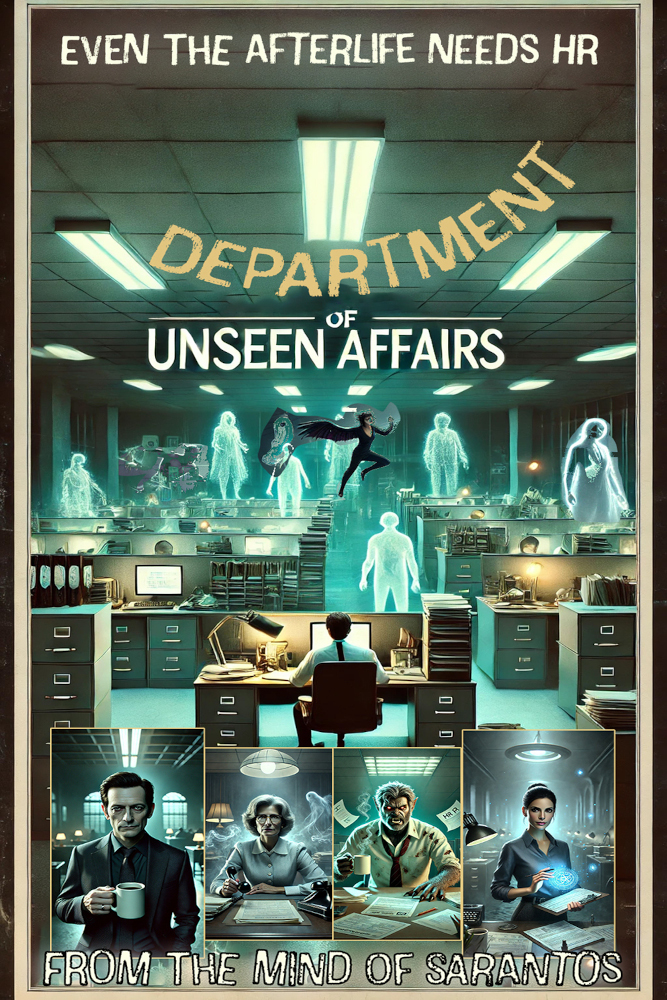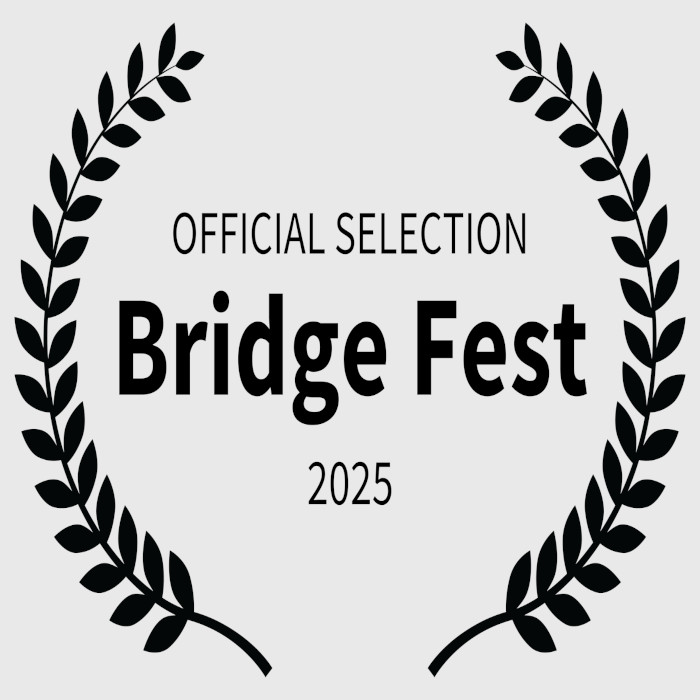
Sarantos Screenplay: Department of Unseen Affairs

Logline:
When a weary new government recruit discovers his posting is to a secret agency managing supernatural bureaucracy, his first day spirals into chaos after he accidentally unleashes a vengeful spectral force — forcing a cynical vampire, a volatile werewolf, and an overworked witch to save both their office and the fragile truce between the living and the dead.
Genre
Supernatural Comedy-Drama (Workplace Fantasy)
Subgenres:
- Paranormal Workplace Comedy
- Supernatural Satire
- Found Family Ensemble
- Mystery / Light Horror Undercurrent
Why This Fits:
- Tone: A blend of sharp workplace banter, supernatural absurdity, and moments of eerie mystery. It balances laugh-out-loud humor with genuine emotional depth — more Ghostbusters meets The Office than traditional horror.
- Structure: Follows the rhythm of a workplace ensemble pilot — new recruit enters a bizarre department, meets eccentric coworkers, breaks something he shouldn’t, and uncovers a deeper mystery connecting the organization’s past to its cursed present.
- Characters: Each archetype subverts expectations — a bureaucratic vampire, a sarcastic witch in HR, a weary werewolf investigator, and a human rookie trying to survive supernatural bureaucracy. The comedy stems from contrast and collision rather than parody.
- Visual and Tonal Blend: Mundane government-office aesthetics fused with darkly whimsical paranormal imagery — fluorescent lights, haunted filing cabinets, levitating paperwork, and deadpan humor in the face of chaos.
In Studio Terms:
If you pitched it to studios or streamers, you’d call it:
“A supernatural workplace dramedy — What We Do in the Shadows meets The Office — with a serialized mystery hook in the spirit of Men in Black and Good Omens.”
Or simply:
“Supernatural Comedy-Drama — The Office meets Ghostbusters with a darkly bureaucratic twist.”
Awards


Synopsis
Alex Mercer just wanted a steady government job — dental, pension, and no explosions. Instead, he reports to the Department of Unseen Affairs: a crumbling bureaucracy where ghosts punch timecards, werewolves complain about overtime, and the coffee machine occasionally levitates. His new colleagues include Claude, a centuries-old vampire with the attitude of a jaded tax auditor; Lila, a caffeine-fueled witch running HR like a crisis hotline; Gary, a snarky werewolf perpetually one paperwork error away from a full moon meltdown; and Gail, a human receptionist who’s seen too much and stopped caring around 1958.
On his first day, Alex joins Claude’s team for what should be a routine case — auditing a ghost still filing tax returns centuries after death. But when Alex accidentally breaks a mystical seal during the inspection, he unleashes a chain reaction that turns the entire office into ground zero for bureaucratic hauntings. Files fly, chairs revolt, and one possessed couch stages a minor uprising. As Claude’s deadpan leadership and Lila’s improvised magic barely hold things together, Alex realizes this agency isn’t just haunted by ghosts — it’s haunted by secrets.
As the supernatural chaos escalates, the team battles spectral paperwork, vengeful office supplies, and the creeping suspicion that something far older than the Department is waking up. Between exorcisms, budget meetings, and HR reprimands, Alex begins to see his bizarre coworkers as something like a family — dysfunctional, immortal, and occasionally on fire.
When the hauntings lead back to a red-sealed file stamped CLASSIFIED: The First Case of Unseen Affairs, Claude’s carefully controlled past threatens to resurface. The deeper Alex digs, the clearer it becomes that the Department was built on something darker than bureaucracy — and some ghosts don’t stay buried forever.
Equal parts supernatural satire and workplace comedy, Department of Unseen Affairs blends the absurdity of office life with the eerie logic of the paranormal. Beneath the jokes and hauntings lies a story about people — living and undead — who are just trying to keep the world running, one cursed form at a time.
Comps
Comp #1 (Two Films):
It’s What We Do in the Shadows meets The Office.
A sharp, supernatural workplace comedy that fuses the deadpan absurdity of office life with the chaos of the paranormal — where ancient creatures wrestle with HR policies, full-moon paperwork, and haunting audits. The humor is situational and character-driven, blending mockumentary-style wit with cinematic supernatural flair.
Comp #2 (Film + Genre Element):
It’s Ghostbusters with the workplace satire of Parks and Recreation.
The script captures the offbeat camaraderie and bureaucratic dysfunction of a government team tasked with managing the afterlife. Equal parts banter, bureaucracy, and banishment, it balances supernatural spectacle with human absurdity — finding heart in the chaos of the cubicle apocalypse.
Comp #3 (Streaming-Friendly Framing):
It’s Men in Black reimagined as a supernatural workplace dramedy for Netflix or FX.
The tone is elevated genre comedy with franchise potential — a high-concept world built around flawed, funny, deeply human characters who just happen to share an office with the undead. Designed for fans of Good Omens, Dead Like Me, and The Umbrella Academy, this project delivers supernatural world-building on a relatable, character-first scale.
Elevator Pitch:
He’s the rookie who still believes in government paperwork. His boss is a vampire who’s been filing it since 1896.
In this sharp, supernatural workplace dramedy, a naïve new employee joins the Department of Unseen Affairs — a crumbling government agency tasked with managing ghosts, werewolves, and things that don’t fit neatly into filing cabinets. On his first day, he accidentally breaks a magical seal, unleashing a haunting that threatens to unravel the fragile truce between the living and the dead.
Now, he and his eternally jaded vampire supervisor must put bureaucracy back in order before the whole system collapses — all while surviving cursed office supplies, sentient furniture, and a haunting that’s far too personal for Claude to ignore.
Department of Unseen Affairs is The Office meets Ghostbusters — a darkly witty, character-driven comedy about burnout, bureaucracy, and the monsters who work 9 to 5 just like the rest of us.
Character Conflict:
Character Conflict Summary:
Claude vs. Alex
Claude’s Core Conflict:
He’s a centuries-old vampire civil servant who’s seen empires fall and paperwork outlive them all. Once a leader during the Department’s founding, he’s now emotionally embalmed — running on procedure, habit, and quiet guilt. His survival depends on detachment, yet beneath the sarcasm and immaculate suits is a man haunted by the one case he couldn’t bury: The First Case of Unseen Affairs.
- Wound: A past failure that cost lives (and afterlives) — the reason he refuses to get close or break protocol.
- Flaw: Treats empathy as inefficiency; values control over connection.
- Fear: That his own buried mistakes will resurface, exposing the monster beneath the bureaucrat — and destroying the fragile order he’s built.
Alex’s Core Conflict:
A well-meaning but insecure human trying to prove his worth in a job he doesn’t understand. He believes competence can protect him — that if he learns every rule, he’ll finally belong. His optimism is his armor, but also his blind spot. His desire to “do the right thing” leads him to break the very systems keeping the Department (and the living world) intact.
- Wound: Chronic professional rejection — he’s been told he “asks too many questions” and “doesn’t fit anywhere.”
- Flaw: Overcompensates through eagerness, assuming action equals value.
- Fear: That he’s destined to fail again, to be the weak link in every system that gives him a chance.
Where They Collide:
Claude represents what Alex fears becoming — numb, unfeeling, resigned to a system that’s forgotten its purpose. Alex represents what Claude lost centuries ago — humanity, idealism, and faith that the work still matters. Their dynamic is mentor vs. rookie, cynic vs. believer, but beneath it lies a shared loneliness neither will admit.
- Claude sees Alex as a liability — too reckless to survive the bureaucracy of the supernatural.
- Alex sees Claude as proof that purpose drains the soul — the embodiment of burnout with fangs.
- Each irritates the other into growth: Claude must rediscover empathy; Alex must learn discipline.
Central Emotional Conflict:
Can a disillusioned immortal rediscover meaning through the idealism of a human who refuses to give up — or will their collision awaken the very darkness Claude buried to protect them all?
Bonus Conflict Dynamics:
- Claude’s centuries of guilt clash with Alex’s naïve sense of justice — one knows rules save lives, the other thinks rules cost them.
- Alex’s impulsive mistake (breaking the seal) literally unearths Claude’s past, forcing both to confront the fallout together.
- Claude needs Alex’s humanity as much as Alex needs Claude’s guidance — but admitting that threatens both their identities.
- Their banter masks dependency — the living and undead halves of a moral system that no longer works without the other.
Why This Conflict Is Strong:
- It’s deeply personal — each man reflects the other’s buried fear: irrelevance.
- It’s philosophical — human idealism vs. immortal pragmatism, ethics vs. efficiency, order vs. redemption.
- It’s plot-driving — Alex’s mistake awakens the Department’s oldest secret, and Claude’s choice to cover it up defines whether they contain it… or become it.
One-Line Character Conflict Summary:
A jaded immortal bureaucrat and an idealistic rookie must survive each other long enough to stop a haunting born from their own mistakes — before the Department they serve consumes them both.
Character Info:
Tailored for industry listings, screenplay databases, and pitch portals.
Character Profiles:
- Alex Mercer
Lead – Male, early 30s. Earnest. Overwhelmed.
Description:
Alex is a well-meaning but chronically unlucky civil servant who’s bounced from one doomed government department to another. He’s the kind of guy who double-checks forms before breathing and still ends up blamed for everything. Idealistic to a fault, Alex believes in systems, rules, and hard work — which makes his assignment to a supernatural bureaucracy both his dream job and his worst nightmare. He wants to matter, to prove he’s not a failure, but in a place run by ghosts and monsters, “doing things by the book” might destroy the book itself.
Character Type:
Relatable, grounded everyman protagonist with comic anxiety and real emotional depth.
Think: Ben Wyatt (Parks and Recreation) meets Shaun (Shaun of the Dead).
Arc:
Alex begins as the naive optimist — the one person who still believes bureaucracy can be good — but his mistake (breaking the Department’s seal) forces him to grow into a more capable, morally courageous investigator. He learns that survival sometimes means breaking the rules — and that courage isn’t about control, but persistence in chaos.
Casting Notes:
Works best with an actor who can balance sincerity with deadpan comedic timing — someone who can sell panic, heart, and heroism in the same breath.
- Claude Laurent
Lead – Male, appears 40s (actually 400+). Sophisticated. Cynical.
Description:
Claude is the vampire equivalent of a mid-level manager — immortal, unflappable, and deeply exhausted. Once a founder of the Department, he’s spent centuries perfecting the art of detached professionalism. His charm is immaculate, his suits impeccable, his sarcasm lethal. But beneath the veneer lies guilt and loss from a past he refuses to discuss. To him, the Department isn’t just a workplace — it’s purgatory, and he’s the one keeping the lights on.
Character Type:
Witty, world-weary antihero with emotional gravitas and dry humor.
Think: Hugh Laurie in House meets Taika Waititi’s Viago in What We Do in the Shadows.
Arc:
Claude begins as emotionally embalmed — surviving, not living — until Alex’s idealism and the resurfacing of an old haunting force him to confront his failures and rediscover purpose. By the end of the pilot, his icy detachment cracks, revealing a reluctant sense of protectiveness and the first hint of redemption.
Casting Notes:
Suited for actors who can blend intelligence, stillness, and subtle vulnerability beneath layers of dry wit — someone equally compelling in silence and in scathing one-liners.
- Lila Winters
Supporting – Female, 30s. Smart. Wry. Compassionate.
Description:
Lila is the Department’s HR witch — equal parts therapist, spellcaster, and caffeine addict. She handles grievances both mortal and magical, managing chaos with warmth and a wicked sense of humor. Behind her sardonic calm lies quiet exhaustion; she’s the only thing holding this misfit team together. Lila’s the emotional anchor in a sea of bureaucratic madness, grounding others even as her own faith in the system frays.
Character Type:
Witty, emotionally intelligent supporting female lead with depth and heart.
Think: Aubrey Plaza in The White Lotus meets Lauren Graham in Gilmore Girls — but magical.
Arc:
Lila’s conflict lies in empathy burnout — she helps everyone else process trauma while repressing her own. Her eventual reawakening comes through small acts of connection and defiance, reminding her that compassion isn’t weakness, it’s rebellion.
Casting Notes:
Best for an actress who excels at balancing sharp comedy with quiet heartbreak — someone who can make warmth feel dangerous and deadpan feel alive.
- Gary Harker
Supporting – Male, late 30s to 40s. Gruff. Loyal. Tired.
Description:
Gary’s a werewolf with seniority issues and sleep deprivation. Once a feared hunter, he now spends his nights filling out Full Moon Leave forms and arguing with HR. Beneath the cynicism is loyalty — he’d die for his team, even if he grumbles the whole way there. His bite is literal, his bark worse, but his humor keeps the group from imploding.
Character Type:
Gruff comic relief with surprising heart and emotional complexity.
Think: Nick Offerman in Parks and Recreation meets Benicio del Toro’s dry menace in The Wolfman.
Arc:
Gary’s battle is with control — the struggle to suppress his instincts in a world that constantly provokes them. His HR sessions with Lila slowly peel back his defenses, revealing a man who resents his curse but fears life without it.
Casting Notes:
Ideal for an actor who can play grounded deadpan humor with physical presence — someone whose smallest gesture can make a growl both hilarious and heartbreaking.
- Gail Temple
Supporting – Female, 50s–60s. Deadpan. Steady. Human.
Description:
Gail is the Department’s receptionist and longest-serving human employee — though some swear she’s immortal by sheer willpower. She’s the eye of the storm: calm, practical, unimpressed by anything supernatural. If the ghosts unionized tomorrow, they’d probably elect her.
Character Type:
Deadpan comedic anchor; the “straight man” in a supernatural circus.
Think: Allison Janney in The West Wing meets Maggie Smith in Downton Abbey.
Arc:
Gail has no arc in the traditional sense — and that’s her power. Her role is to ground everyone else’s madness, her consistency the rare constant in an ever-changing world. She’s proof that resilience can be its own kind of magic.
Casting Notes:
Perfect for an actress with dry delivery, maternal gravity, and impeccable timing — someone who can steal a scene with one unimpressed look.
Budget:
Mid-range budget for a supernatural workplace dramedy with contained world-building and ensemble-driven comedy.
Estimated Budget Category: $15M–$25M USD
This positions it alongside other stylized supernatural comedies and genre-leaning streaming pilots — ambitious in design, but controlled through its centralized setting and dialogue-first storytelling.
Why this Budget Range Works:
Primary Costs:
- Cast: 4–5 primary ensemble roles (potential for name talent or high-profile TV actors) plus a handful of recurring supernatural characters with limited screen time.
- Location: Predominantly a single contained environment — the Department of Unseen Affairs headquarters — supported by a few key secondary sets (haunted house, break room, archive).
- Production Design: Heavy emphasis on visual tone — retro bureaucracy meets supernatural decay. Requires practical effects, detailed set dressing, and subtle VFX for floating files, flickering lights, and ambient hauntings.
- VFX / Special Effects: Moderate but essential — ghostly apparitions, glowing seals, levitating objects, and atmospheric enhancements. Primarily compositing and motion control rather than full CGI.
- Wardrobe/Makeup: Distinctive yet budget-friendly — business attire with supernatural flair (fangs, subtle prosthetics, magical accents).
Production Style:
- Mostly contained to the Department offices, allowing efficient scheduling (25–30 shooting days).
- Scenes are character-driven with controlled supernatural gags that can be handled via practical and post-production VFX hybrids.
- Genre tone leans on dialogue, performance, and environment rather than spectacle — closer to What We Do in the Shadows or Good Omens than a high-VFX tentpole.
Comparable Projects:
- What We Do in the Shadows (Series, FX – Est. $15M–$20M per season)
- Ghostbusters: Afterlife (Stylistically aligned but far higher budget; this would be the contained-comedy version)
- The Umbrella Academy (similar tone blend, but this script’s scale and effects are much more contained)
- Good Omens (Amazon – tone reference, though this project would target a leaner, more office-centric scope)
Special Studio Note:
If the production leans into practical lighting effects and stylized in-camera illusions — floating props, layered sound design, and clever editing — the budget could feasibly drop closer to $10M–$15M while maintaining cinematic polish. That would make it especially appealing for streamers or mid-tier studios seeking elevated genre comedy with strong franchise potential.
Pitch Sheet:
Project Title: Department of Unseen Affairs
Genre: Supernatural Comedy-Drama
Subgenres: Workplace Satire · Paranormal Bureaucracy · Found Family Ensemble
Tagline: Even the afterlife needs HR.
Elevator Pitch: He’s the rookie who still believes in government paperwork. His boss is a vampire who’s been filing it since 1896.
When an idealistic new civil servant joins the Department of Unseen Affairs — a dusty government agency that manages supernatural disputes — he accidentally unleashes a haunting that threatens to unravel the fragile truce between the living and the dead. Now, alongside his jaded vampire supervisor, an HR witch with burnout, and a sarcastic werewolf investigator, he must restore bureaucratic balance before the office — and reality — collapses under the weight of unfinished business.
Think The Office meets Ghostbusters, with the tonal bite of Good Omens and the workplace absurdity of Parks and Recreation.
Tone & Vibe:
Darkly funny, character-driven, and emotionally sharp. The tone walks the line between bureaucratic satire and supernatural mystery — balancing heart, horror, and humor. Imagine Men in Black filtered through What We Do in the Shadows and The IT Crowd.
The humor comes from exhaustion, irony, and the quiet horror of middle management — except your middle management drinks blood and files hauntings in triplicate.
Logline:
When a well-meaning new government employee joins a secret department that mediates disputes between the living and the dead, his first-day mistake triggers a chain of supernatural chaos that even a vampire boss, a caffeine-addicted HR witch, and a grumpy werewolf can’t immediately contain. To fix it — and survive — they’ll have to confront a haunting born from the Department’s oldest, most classified secret.
Key Selling Points:
- Fresh tonal fusion: Combines workplace comedy with supernatural mystery — witty, cinematic, and emotionally grounded.
- Ensemble-driven: Dynamic mix of personalities — the disillusioned immortal, the idealistic rookie, and the human HR witch who keeps the chaos humane.
- Contained production: Primarily set in one stylized location — the Department headquarters — allowing high visual impact on a moderate budget.
- Scalable franchise potential: The Department’s world easily expands into case-of-the-week storytelling or serialized lore-driven arcs.
- Market-ready tone: Witty, clever, and highly rewatchable — perfect for audiences who love smart supernatural comedies with heart.
Primary Audience:
Fans of Good Omens, What We Do in the Shadows, The Office, Dead Like Me, and The Umbrella Academy.
Ideal for streamers like Netflix, Prime Video, FX, or Hulu — platforms known for genre-mixing shows with sharp ensemble casts and cult rewatch appeal.
Market Positioning:
A supernatural workplace dramedy with emotional intelligence and commercial flair. Perfectly pitched for streaming audiences craving humor with heart and world-building — the next cult favorite in waiting for fans who love workplace dysfunction with a supernatural twist.
Budget Category:
Mid-range ($15M–$25M USD). Contained sets with scalable VFX and strong character focus, ideal for high production value without blockbuster costs.
Lead Characters:
Alex Mercer – 30s
A well-meaning but overwhelmed new hire whose optimism is both his power and his curse. He wants to matter — but his first-day mistake might doom them all.
Type: Earnest underdog, accidental disruptor.
Think: Ben Wyatt (Parks and Recreation) meets Shaun (Shaun of the Dead).
Claude Laurent – Appears 40s (actually 400+).
A vampire bureaucrat with old-world charm and centuries of burnout. He hides regret behind sarcasm and perfectionism, leading the Department like a man keeping purgatory tidy.
Type: World-weary antihero with dry wit.
Think: Hugh Laurie in House meets Taika Waititi in What We Do in the Shadows.
Lila Winters – 30s.
A witch who runs HR like a triage center for the emotionally and magically unstable. Exhausted, sharp, and secretly soft.
Type: Empathic truth-teller, sarcastic caretaker.
Think: Aubrey Plaza meets Lauren Graham — with a cauldron.
Gary Harker – 40s.
A grumpy werewolf investigator who treats every crisis like another unpaid overtime shift. Loyal, snarky, and secretly longing for peace.
Type: Rough-edged heart with a bite.
Think: Nick Offerman meets Benicio del Toro.
Themes:
- Bureaucracy vs. the supernatural — red tape as a modern haunting.
- Burnout, guilt, and the search for purpose in a system that’s forgotten its soul.
- Humanity as both flaw and strength — even the undead need connection.
- Found family in the most dysfunctional workplace imaginable.
Why It Works for Big Studios or Streamers:
- Instantly hookable concept — “the supernatural DMV” — with strong comedic and visual identity.
- Ensemble format with built-in franchise longevity (case-driven or serialized).
- Perfect for mid-tier budgets with high creative ROI.
- Market-tested tone: Audiences are hungry for dark comedies with heart (The Bear, Wednesday, Good Omens).
- Ideal for talent synergy — star-driven ensemble potential and breakout newcomer arcs.
In Studio Terms:
It’s The Office meets Ghostbusters — a supernatural workplace comedy with the emotional backbone of Good Omens and the visual wit of Men in Black.
Script:
This document is view-only for content protection.
If you’d like a personal copy to read, please email me at info@melogia.com
Follow Sarantos:
- Website: www.melogia.com
- Amazon: Sarantos on Amazon
- Author’s Guild: Author’s Guild
- BookBaby: Sarantos on BookBaby
- YouTube: SarantosMelogia
- Goodreads: Sarantos on Goodreads
- Facebook: @SarantosMelogia
- Instagram: @SarantosMelogia
- Twitter: @SarantosMelogia
- TikTok: @Sarantos




















